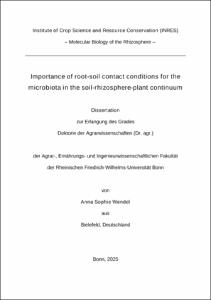Importance of root-soil contact conditions for the microbiota in the soil-rhizosphere-plant continuum
Importance of root-soil contact conditions for the microbiota in the soil-rhizosphere-plant continuum
| dc.contributor.advisor | Knief, Claudia | |
| dc.contributor.author | Wendel, Anna Sophie | |
| dc.date.accessioned | 2025-01-14T14:49:02Z | |
| dc.date.issued | 14.01.2025 | |
| dc.identifier.uri | https://hdl.handle.net/20.500.11811/12730 | |
| dc.description.abstract | The contact zone between a root and the surrounding soil mediates processes such as nutrient and water uptake and the interaction with microorganisms. Despite the importance of the contact zone, there is a lack of understanding of the specific characteristics and their relevance to plant performance and microbial colonization. The objective of this thesis was, therefore, to investigate the effect of the extent and characteristics of this root-soil contact zone on plant performance and microbial abundance, and community structure. In particular, I addressed the following research questions: I.) How do specific root traits impact the establishment of a contact zone and how do variations in the root-soil contact zone influence corresponding plant and microbial parameters?, II.) How do root-soil contact zone conditions furthermore modulate these responses? and III.) How do root-soil contact zone conditions modulate these responses in the field? In order to answer these questions, I conducted a literature review, two microcosms, and one field experiment. To modify the root-soil contact zone, I grew maize plants in treatments with artificial pores (abiogenic pores), with pores incubated with earthworms (biogenic pores), and, as a control, without additional pores. To analyze the microbial abundance and community diversity and composition, qPCR, fluorescence microscopy, and amplicon sequencing were used. Plant performance was assessed by endoscopy and measurements of plant height and weight and shoot nutrient contents. My results confirmed that the root-soil contact significantly influenced the occurrence of microorganisms on the root surface, as well as the diversity and composition of the bacterial community in the rhizosphere. The root-soil contact was especially important for nitrogen cycling microorganisms in the rhizosphere, as nitrifying bacteria were less abundant when the root established only partial soil contact. However, the level of root-soil contact had no effects on early plant performance in the microcosm experiments (research question I). When the contact zone between root and soil was enriched in nutrients, due to soil faunal activity in pores, the abundance of microorganisms at the pore wall as well as in the corresponding rhizosphere was increased, and microbial community composition was influenced (Research question II). The same trends can be seen in the field. Moreover, in the field experiment, which also covered later growth stages, reduced root-soil contact due to the presence of abiogenic pores resulted in growth deficits compared with the presence of biogenic pores and the absence of soil pores (Research question III). In summary, these findings underline the importance of root-soil contact and contact zone characteristics for rhizosphere processes and plant performance. Agricultural management should, therefore, aim to minimize cracks in the soil to guarantee root-soil contact and to improve plant performance by enhancing biological activity in pores. | en |
| dc.language.iso | eng | |
| dc.rights | In Copyright | |
| dc.rights.uri | http://rightsstatements.org/vocab/InC/1.0/ | |
| dc.subject | Wurzel-Boden Kontakt | |
| dc.subject | Mikrobiom | |
| dc.subject | Rhizosphäre | |
| dc.subject | Endosphäre | |
| dc.subject | Root-soil contact | |
| dc.subject | Microbiome | |
| dc.subject | Rhizosphere | |
| dc.subject | Endosphere | |
| dc.subject.ddc | 630 Landwirtschaft, Veterinärmedizin | |
| dc.title | Importance of root-soil contact conditions for the microbiota in the soil-rhizosphere-plant continuum | |
| dc.type | Dissertation oder Habilitation | |
| dc.identifier.doi | https://doi.org/10.48565/bonndoc-483 | |
| dc.publisher.name | Universitäts- und Landesbibliothek Bonn | |
| dc.publisher.location | Bonn | |
| dc.rights.accessRights | embargoedAccess | |
| dc.date.embargoEndDate | 01.06.2026 | |
| dc.identifier.urn | https://nbn-resolving.org/urn:nbn:de:hbz:5-80498 | |
| dc.relation.doi | https://doi.org/10.1007/s11104-022-05406-4 | |
| ulbbn.pubtype | Erstveröffentlichung | |
| ulbbnediss.affiliation.name | Rheinische Friedrich-Wilhelms-Universität Bonn | |
| ulbbnediss.affiliation.location | Bonn | |
| ulbbnediss.thesis.level | Dissertation | |
| ulbbnediss.dissID | 8049 | |
| ulbbnediss.date.accepted | 19.11.2024 | |
| ulbbnediss.institute | Agrar-, Ernährungs- und Ingenieurwissenschaftliche Fakultät : Institut für Nutzpflanzenwissenschaften und Ressourcenschutz (INRES) | |
| ulbbnediss.fakultaet | Agrar-, Ernährungs- und Ingenieurwissenschaftliche Fakultät | |
| dc.contributor.coReferee | Amelung, Wulf |
Dateien zu dieser Ressource

Dieses Dokument ist zur Zeit gesperrt.
Das Dokument erscheint in:
-
E-Dissertationen (1116)



